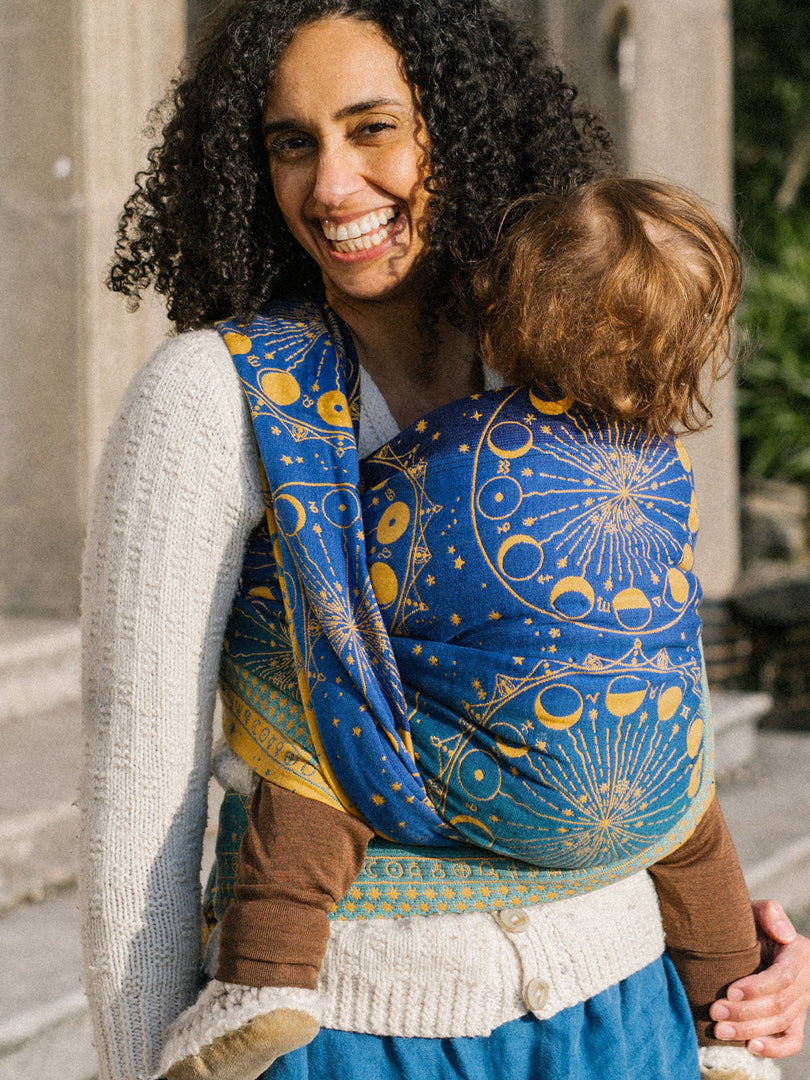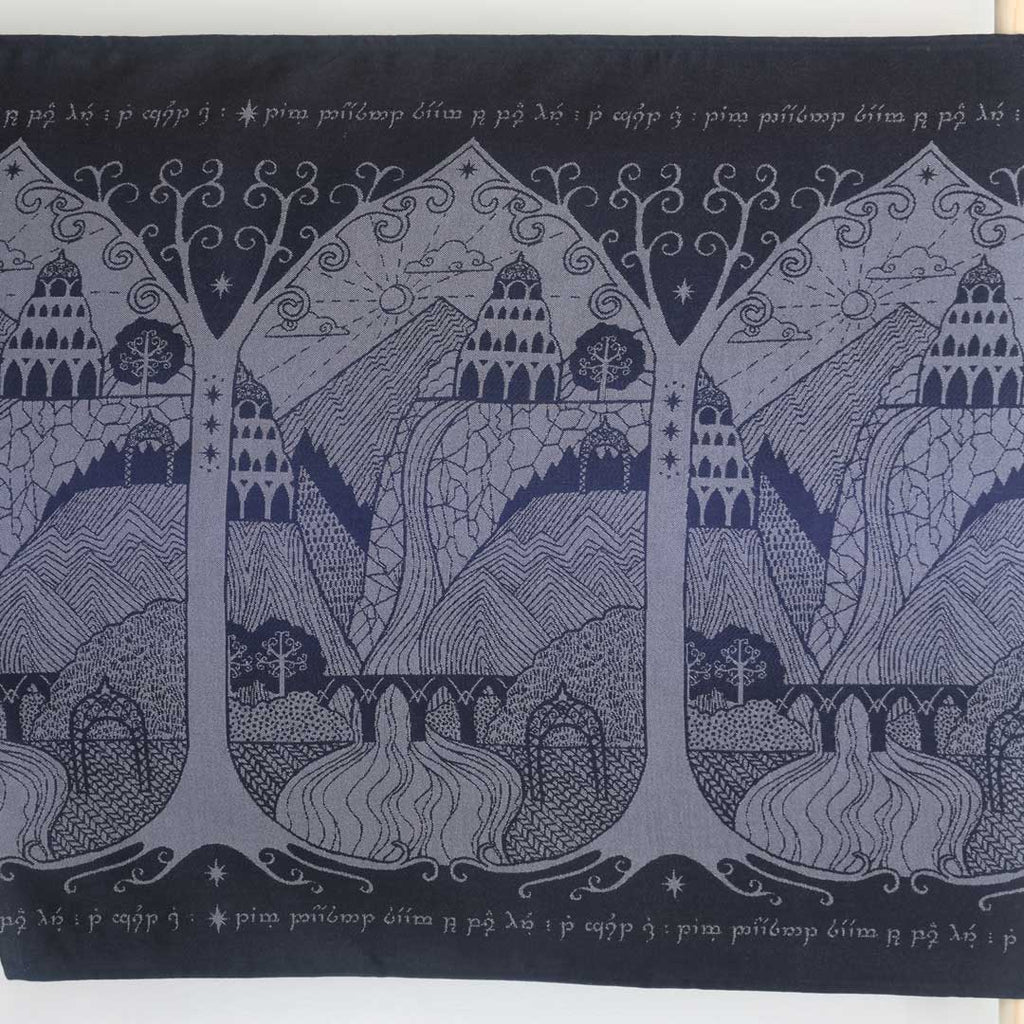
Can A Baby Face Forward In A Sling?
You may have seen sweet images of babies facing forward in a sling and want to try it. Perhaps you consider it a stage in the process of using a sling, maybe you think your baby is too curious and needs to face outwards.
This article explores the myths, facts, and alternative options for facing forward in a sling so you can choose the right option for you and your child, even though you might have heard that facing forwards in a sling is bad for babies' hips or is too overwhelming for them.
Parents often ask if it's ok for their babies to face forward in a sling. We see lots of images in the media of celebrity babies facing forward in slings. Naturally, television, film and adverts want the audience to see the cute, smiling baby's face so they feature them this way. Consequently, after viewing these images, many people naturally assume that forward facing is a developmental stage that all babies must undergo at a certain age.
This assumption is often seemingly backed up when baby's go through the 'nosy' stage at around 3 months. They stay awake for longer stretches and become aware of life happening around them. They crane their necks to look around, causing many parents to worry that they dislike being carried facing inward and prefer to see more.
While part of this development involves them paying more attention to their surroundings, it's also about them practicing their newfound head control. It's not until between 8-12 months that babies can see far enough to focus on objects on the other side of a room. So, although young babies do become more interested in the world around them, they still cannot actually see very far.
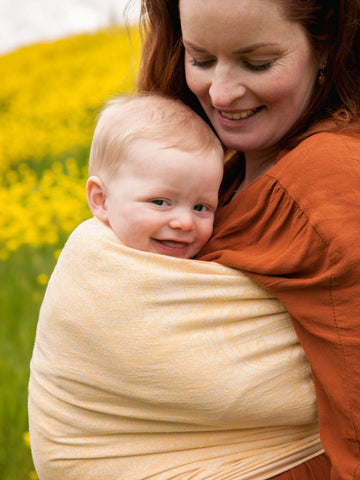
Baby Enjoying Facing Out In A Ring Sling
Are Forward Facing Carriers Safe?
There Forward-facing carriers have a lot of negativity surrounding them due to myths about them being bad for baby's hips and spines, unsafe, and overstimulating. However, if your baby doesn't have any underlying hip issues and you remember the safety guidelines, there is nothing dangerous about forward facing. There are some important points to remember:
·You should consider this position only when your baby has excellent head control and when there is no danger of their head bouncing around when you walk. Additionally, your baby needs to be tall enough for their chin to clear the top of the sling, ensuring their face remains clear of any fabric or obstruction. Therefore, you typically don't consider this position until your baby reaches around 4-6 months old.
·If you choose to face your baby forward in a sling, you should never allow them to sleep in this position. Sleeping while facing forward can pose a danger to their airway if their chin flops onto their chest.
·The recommended duration for forward facing in a carrier is no longer than 20-30 minutes. We'll explore the reasons for this below.
· It can be uncomfortable for the parent or caregiver, so it's best avoided if you have back problems.
Why Can't You Forward Face In An Oscha sling?
Hip Position
Only some brands offer a forward facing option. In this position the base of the sling must be narrow enough to go between the front of your child's legs and seat them comfortably without overspreading the hips. Oscha carriers are designed to support your baby in a parent-facing, wide-based ergonomic 'M' position. This 'M' shape is created when your sling supports all the way along the baby's leg to their knee pits. It tilts their pelvis towards you with their knees sitting higher than their bottom.
The spread squat encourages optimal development and the formation of a deep socket joint in your baby's maturing hips..
Read more about Oscha's accreditation with the International Hip Dysplasia Institute.
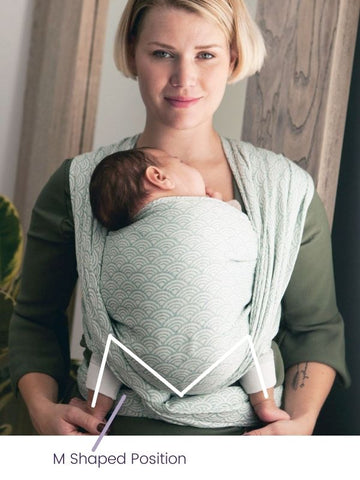
The Time Limit On Facing Forward
This parent-facing position also enables you to keep your baby in a sling for longer periods. Parents often find it surprising to learn that forward facing in a sling has a time limit. There are several reasons why experts recommend limiting this position to 20-30 minutes:
· Achieving the optimal spread squat position is easier when you position their tummy against your body and allow them to curl into you. When you turn your baby around so that their spine is against you, supporting the hips and tilting their pelvis becomes much harder. This position can also create a curve in the other direction, exerting pressure on the baby's spine.
· If your baby becomes overwhelmed in this position they cannot turn their head away or seek comfort from their caregiver. So you have to be very mindful of your baby's cues and turn them back around when necessary.
· When your child's spine curves in towards you, they work with your center of gravity. Turning them around and facing out works against your center of gravity and makes the load awkward to carry.
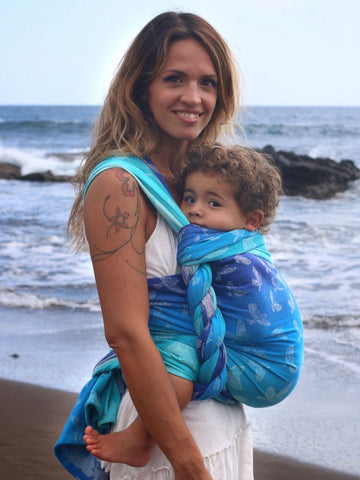
Parent Facing carry with Oscha Baby Wrap
The Time Limit On Parent Facing
There's no time limit when carrying in a parent-facing position, whether on your front, hip or back. Oscha slings are designed to be used only in these parent-facing positions, which support developing hips and spines. The soft woven wrap fabric moulds around your baby and yourself, making it comfortable for you both for long periods of time.
For most families there's no real need to forward face in a sling and many enjoy the benefits offered by parent-facing. It can help develop a baby's communication skills and speech.
The Benefits of Parent Facing
Studies* have shown that parents are twice as likely to interact with their child if they are in a parent-facing pram. And twice as likely again if they were being carried.
This interaction all helps shape a child's brain. From their early days babies pick up on facial communication cues. They learn about expressions, emotions and to recognise people. So being held close, and being able to see your face all aids this development.
Are there other options instead of facing forward?
Of course, babies do become interested in seeing the world around them. There are lots of ways of facilitating this, not just using a forward facing sling.
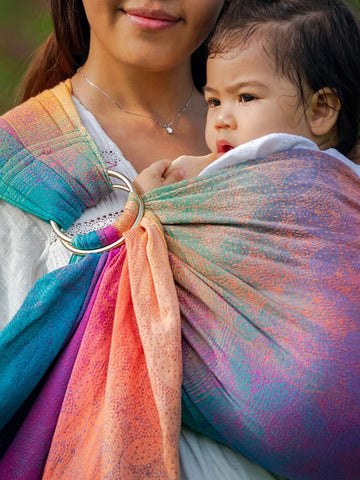
In a parent-facing position
You can still give your baby a good view and take advantage of all the benefits of front carrying in a parent-facing position. If you're using a wrap try a slightly different carry. Try flipping the shoulders of your wrap to move the material away from their face. A ring sling, because of it's one shouldered nature offers a nice open view. You can also try a
different position other than the standard tummy to tummy. Seated sideways or an off-centre position gives more room to look around and is great for babies who are too young for a hip carry.
A hip carry is a great alternative
Here your baby's still supported in a comfortable knee to knee position. The carry doesn't work against your centre of gravity, they can cuddle in while still seeing everything and there's no time limit. You can usually hip carry from around 4 months. However, be guided by your baby and when you're comfortable carrying on your hip without a sling. You can hip carry in a wrap, ring sling or any of Oscha's carriers.
Back carrying can be practical and fun
This is another fantastic option to give your baby a great view and it can be lots of fun. When using a carrier it's recommended that you wait until your baby is beginning to sit before trying a back carry. Once they've hit that developmental stage there's no restriction in how long they stay in this position. They can see the world but if they become overwhelmed it's easy to move their head away. They can also sleep while in a back carry. One of the loveliest things when carrying my children was that gentle thump of their head on my shoulder as they drifted off to sleep.
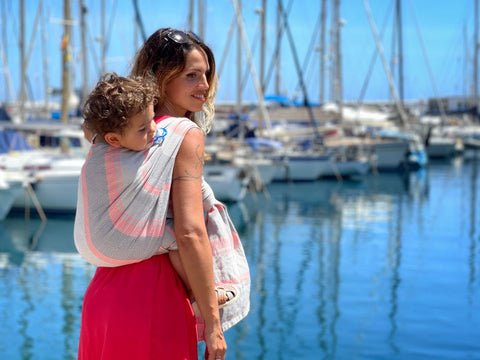
Back Carry in Colsie Coral Sling
So remember there are lots of options out there for having your baby face forward in a sling. Forward facing is not dangerous and some families enjoy it, but it definitely has its limitations. Its popularity is more to do with societal expectations than a definite developmental need. Every baby becomes more interested in the world around them and we can use our slings in lots of ways to help with this.
Remember that the most important thing to your child is you! Your baby will enjoy seeing you, interacting with you and snuggling in when the world becomes just a little bit too exciting.
Written by Jillyan Graham
Jill is a Baby Carrying Consultant based in the Scottish Borders and is Mum to two girls.
For more info about the work that she does visit: Carry Me Round
Citations
Zeedyk, M. S. (2008). What's life in a baby buggy like? Research report
published by the National Literacy Trust , Talk to Your Baby Campaign.
https://www.literacytrust.org.uk/talk_to_your_baby/resources/1555_whats_life_in
_a_baby_buggy_like
Blaiklock, K. (2013). Talking with children when using prams while shopping.
New Zealand Research in Early Childhood Education Journal, 16, 15-28.

